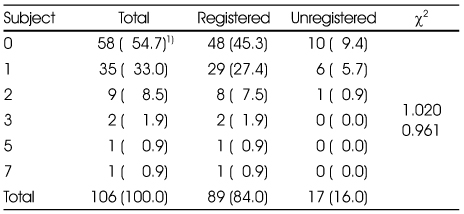Articles
- Page Path
- HOME > Korean J Community Nutr > Volume 20(4); 2015 > Article
-
Research Article
- The Current State of Food Allergy of Preschool Childcare Facilities in Hanam
- Wookyoun Cho, Jinah Kim
-
Korean Journal of Community Nutrition 2015;20(4):251-258.
DOI: https://doi.org/10.5720/kjcn.2015.20.4.251
Published online: August 30, 2015
1Department of Food and Nutrition, College of BioNano Technology, Gachon University, Gyeonggi, Korea.
2Hanam Center for Children's Foodservice Management, Gyeonggi, Korea.
- Corresponding author: Wookyoun Cho. Department of Food and Nutrition, College of BioNano Technology, Gachon University, 1342 Seongnam-daero, Sujeonggu, Seongnam-si, Gyeonggi 13120, Korea. Tel: (031) 750-5972, Fax: (031) 750-5974, wkcho@gachon.ac.kr
Copyright © 2015 The Korean Society of Community Nutrition
This is an Open-Access article distributed under the terms of the Creative Commons Attribution Non-Commercial License (http://creativecommons.org/licenses/by-nc/3.0/) which permits unrestricted non-commercial use, distribution, and reproduction in any medium, provided the original work is properly cited.
- 1,336 Views
- 2 Download
- 5 Crossref
Figure & Data
REFERENCES
Citations

- Knowledge and management of food allergy by parents of preschool children who experience food allergies
Seung Hui Kim, Seung-Min Lee
Journal of Nutrition and Health.2023; 56(2): 184. CrossRef - Cleaning Methods to Effectively Remove Peanut Allergens from Food Facilities or Utensil Surfaces
Sol-A Kim, Jeong-Eun Lee, Jaemin Shin, Won-Bo Shim
Journal of Food Hygiene and Safety.2023; 38(4): 228. CrossRef - Risk factors for food allergy among children in Seoul: focusing on dietary habits and environmental factors
Mijung Jang, KyooSang Kim
Journal of Nutrition and Health.2019; 52(6): 559. CrossRef - Study on the snack menu pattern, food diversity and satisfaction of parent provided by Center for Children's Foodservice Management in Jeonbuk area
Eun-Byul Sym, Jeong-Ok Rho
Journal of Nutrition and Health.2019; 52(5): 501. CrossRef - Food allergic reactions in the community: a questionnaire survey of caregivers
An Deok Seo, Jun Yeol Lee, Song I Yang, Hye Ran Lee, So-Yeon Lee
Allergy, Asthma & Respiratory Disease.2017; 5(1): 27. CrossRef

Fig. 1
General characteristics of childcare facilities
1) N (%)
**: P < 0.01 significantly different between registered and unregistered facilities by chi square test
Numbers of children with food allergy by childcare facilities
1) N (%)
Occurrences of food allergy in children according to gender and ages
1) Significantly different by independent t-test
2) Significantly different by one way ANOVA
***: P < 0.001
The allergy inducing foods
1) N (%)
Clinical symptoms of food allergy
Principal's recognition of necessity for food allergy education
1) Mean±SD
5-point Likert scale (not needed at all=1, strongly needed=5)
*: P < 0.05 significantly different between facilities with food allergic children and facilities without food allergic children by independent t-test
1) N (%) **: P < 0.01 significantly different between registered and unregistered facilities by chi square test
1) N (%)
1) Significantly different by independent t-test 2) Significantly different by one way ANOVA ***: P < 0.001
1) N (%)
1) Mean±SD 5-point Likert scale (not needed at all=1, strongly needed=5) *: P < 0.05 significantly different between facilities with food allergic children and facilities without food allergic children by independent t-test

 KSCN
KSCN







 Cite
Cite


